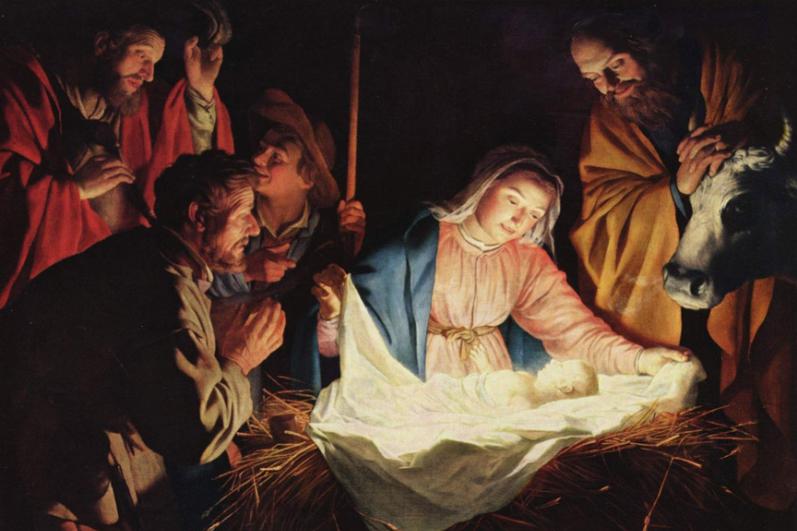The Lord is born
We celebrate the Nativity of Our Lord and Savior Jesus Christ on Dec. 25. Together with its "octave day," Jan. 1, the solemnity of Mary the Mother of God, they are the only celebrations on our Roman Catholic calendar that are also federal and state holidays in the U.S. The 16 days of the Christmas season are crowded with additional solemnities -- the above-mentioned Jan. 1 and the Epiphany of Our Lord and Savior Jesus Christ, and several feasts: St. Stephen, Dec. 26; St. John the Evangelist, Dec. 27; Holy Innocents, Dec. 28; The Holy Family of Jesus, Mary, and Joseph, Dec. 30; the Baptism of the Lord, Jan. 9; there are memorials of saints on almost every other day of the Christmas season.
How we arrived at Dec. 25 as the birthday of the Messiah is a long and complicated story with twists and turns. As with many liturgical celebrations in our Roman Catholic liturgy, they are all related to Easter, which is the prime celebration of the Christian faith.
There are four Masses for Christmas, each with different prayers in the Roman Missal and assigned biblical texts in the Lectionary: the Vigil Mass, the Mass during the night (commonly called midnight Mass); the Mass at Dawn (often called the Shepherds' Mass); and the Mass during the day. There is an interesting history and explanation for each of these Masses.
During the Twelve Days of Christmas -- made popular by the song or carol of that name -- multiple celebrations are bracketed by Christmas itself and the solemnity of the Epiphany. Three days immediately following Christmas are given to the "comites" or companions of Christ: Stephen, Dec. 26; John the Evangelist, Dec. 27; and the Holy Innocents, Dec. 28. They are placed closest to Christ because they represent the three ways in which one can become a saint. Preaching about Christ and being martyred for him -- Stephen; preaching about Christ but not being martyred for him -- John; and being martyred for him but not preaching -- Holy Innocents. Every saint -- which is what we all hope to be -- has, does, or will follow Christ in one of these three ways.
The feast of the Holy Family is relatively new and newly placed during the 12 days of Christmas. Epiphany is the time for the exchange of gifts, especially for children in many European cultures and for those influenced by the transmission of the faith from such European nations as Italy and Spain. For Eastern Christians, both Roman Catholic and Orthodox, Epiphany is the most important of the Christmas feasts.
The last day of the Christmas season is the feast of the Baptism of the Lord, celebrated this year on Jan. 9. Christmas decorations and creche scenes should remain in churches and homes until that date. It is not easy in our culture to keep the Christmas spirit alive. There is a line that says, remember that the 12 days of Christmas are Dec. 25 to Jan. 6; NOT Dec. 12 to 24!
Epiphany was for some time the only other day when baptisms would be celebrated; the only other date was Easter. The "problem" was the increase in the number of those seeking baptism could no longer be accommodated at Easter. Since Epiphany also commemorated the Baptism of the Lord in the East, it was the logical additional day to celebrate baptisms.
For those who look for further references and resources: "The Origins of Christmas (revised)" by Joseph Kelly (Paulist Press, 2014) provides an excellent and accessible historical, liturgical, and theological explanation of the Christmas feast we now have. For a fine presentation of the customs and devotions associated with Christmas: "The Christmas Book" by Father Francis X. Weiser, SJ (St. Augustine Academy Press, 2014).
The late Father Raymond Brown's "The Birth of the Messiah," (updated edition, Doubleday, 1993) is the yet-to-be equaled commentary on the scriptural accounts in the Gospels of Matthew and Luke of the conception and birth of the Lord. At 750 pages, it is a daunting text, but, as so often with Father Brown's work, it breathes love of Scripture, love of the Church, and love of his topic: Jesus Christ.
Last, check out the website of the Office for Divine Worship of the Archdiocese of Los Angeles, lacatholics.org/departments-ministries/worship-office. There is a wealth of information there, and the multicultural reality of Los Angeles shines at this site. Sign up for its excellent newsletter at laworship.flocknote.com/OFWMailingList.



















